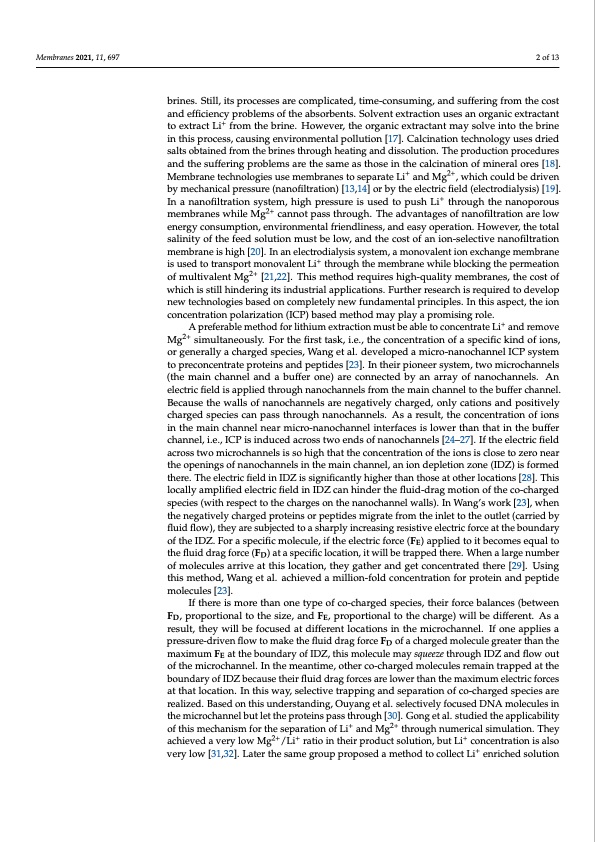
PDF Publication Title:
Text from PDF Page: 002
Membranes 2021, 11, 697 2 of 13 brines. Still, its processes are complicated, time-consuming, and suffering from the cost and efficiency problems of the absorbents. Solvent extraction uses an organic extractant to extract Li+ from the brine. However, the organic extractant may solve into the brine in this process, causing environmental pollution [17]. Calcination technology uses dried salts obtained from the brines through heating and dissolution. The production procedures and the suffering problems are the same as those in the calcination of mineral ores [18]. Membrane technologies use membranes to separate Li+ and Mg2+, which could be driven by mechanical pressure (nanofiltration) [13,14] or by the electric field (electrodialysis) [19]. In a nanofiltration system, high pressure is used to push Li+ through the nanoporous membranes while Mg2+ cannot pass through. The advantages of nanofiltration are low energy consumption, environmental friendliness, and easy operation. However, the total salinity of the feed solution must be low, and the cost of an ion-selective nanofiltration membrane is high [20]. In an electrodialysis system, a monovalent ion exchange membrane is used to transport monovalent Li+ through the membrane while blocking the permeation of multivalent Mg2+ [21,22]. This method requires high-quality membranes, the cost of which is still hindering its industrial applications. Further research is required to develop new technologies based on completely new fundamental principles. In this aspect, the ion concentration polarization (ICP) based method may play a promising role. A preferable method for lithium extraction must be able to concentrate Li+ and remove Mg2+ simultaneously. For the first task, i.e., the concentration of a specific kind of ions, or generally a charged species, Wang et al. developed a micro-nanochannel ICP system to preconcentrate proteins and peptides [23]. In their pioneer system, two microchannels (the main channel and a buffer one) are connected by an array of nanochannels. An electric field is applied through nanochannels from the main channel to the buffer channel. Because the walls of nanochannels are negatively charged, only cations and positively charged species can pass through nanochannels. As a result, the concentration of ions in the main channel near micro-nanochannel interfaces is lower than that in the buffer channel, i.e., ICP is induced across two ends of nanochannels [24–27]. If the electric field across two microchannels is so high that the concentration of the ions is close to zero near the openings of nanochannels in the main channel, an ion depletion zone (IDZ) is formed there. The electric field in IDZ is significantly higher than those at other locations [28]. This locally amplified electric field in IDZ can hinder the fluid-drag motion of the co-charged species (with respect to the charges on the nanochannel walls). In Wang’s work [23], when the negatively charged proteins or peptides migrate from the inlet to the outlet (carried by fluid flow), they are subjected to a sharply increasing resistive electric force at the boundary of the IDZ. For a specific molecule, if the electric force (FE) applied to it becomes equal to the fluid drag force (FD) at a specific location, it will be trapped there. When a large number of molecules arrive at this location, they gather and get concentrated there [29]. Using this method, Wang et al. achieved a million-fold concentration for protein and peptide molecules [23]. If there is more than one type of co-charged species, their force balances (between FD, proportional to the size, and FE, proportional to the charge) will be different. As a result, they will be focused at different locations in the microchannel. If one applies a pressure-driven flow to make the fluid drag force FD of a charged molecule greater than the maximum FE at the boundary of IDZ, this molecule may squeeze through IDZ and flow out of the microchannel. In the meantime, other co-charged molecules remain trapped at the boundary of IDZ because their fluid drag forces are lower than the maximum electric forces at that location. In this way, selective trapping and separation of co-charged species are realized. Based on this understanding, Ouyang et al. selectively focused DNA molecules in the microchannel but let the proteins pass through [30]. Gong et al. studied the applicability of this mechanism for the separation of Li+ and Mg2+ through numerical simulation. They achieved a very low Mg2+/Li+ ratio in their product solution, but Li+ concentration is also very low [31,32]. Later the same group proposed a method to collect Li+ enriched solutionPDF Image | Brines Based on Free Flow Ion Concentration Polarization

PDF Search Title:
Brines Based on Free Flow Ion Concentration PolarizationOriginal File Name Searched:
membranes-11-00697-v2.pdfDIY PDF Search: Google It | Yahoo | Bing
Product and Development Focus for Infinity Turbine
ORC Waste Heat Turbine and ORC System Build Plans: All turbine plans are $10,000 each. This allows you to build a system and then consider licensing for production after you have completed and tested a unit.Redox Flow Battery Technology: With the advent of the new USA tax credits for producing and selling batteries ($35/kW) we are focussing on a simple flow battery using shipping containers as the modular electrolyte storage units with tax credits up to $140,000 per system. Our main focus is on the salt battery. This battery can be used for both thermal and electrical storage applications. We call it the Cogeneration Battery or Cogen Battery. One project is converting salt (brine) based water conditioners to simultaneously produce power. In addition, there are many opportunities to extract Lithium from brine (salt lakes, groundwater, and producer water).Salt water or brine are huge sources for lithium. Most of the worlds lithium is acquired from a brine source. It's even in seawater in a low concentration. Brine is also a byproduct of huge powerplants, which can now use that as an electrolyte and a huge flow battery (which allows storage at the source).We welcome any business and equipment inquiries, as well as licensing our turbines for manufacturing.| CONTACT TEL: 608-238-6001 Email: greg@infinityturbine.com | RSS | AMP |